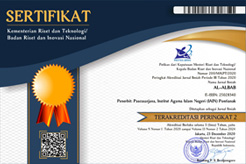Music in The Liturgy of The Catholic Community in Jakarta, Indonesia
Abstract
Keywords
Full Text:
PDFReferences
Adimurti, J. T. (2005). Inkulturasi Musik Gereja Di Batak Toba Dan Simalungun. VI (3).
Adiprasetya, J. (2019). The Liturgy of the In-Between. 72(1): 82–97.
Agung, L. (2017). Estetika (Pengantar Sejarah dan Konsep). Yogyakarta: Kanisius.
Cockayne, J. (2018a). Philosophy and Liturgy Part 1. Liturgy and Philosophy of Action. (April): 1–9.
------. (2018b). Philosophy and Liturgy Part 2. Liturgy and Epistemology. (April): 1–10.
Don, Y. and Bakok, B. (1993). Musik Liturgi Inkulturatif Di Gereja Ganjuran Yogyakarta Sejarah Dan Landasan Konstitusional. (50).
Dumitrescu, T. (2011). Stefano Mengozzi, The Renaissance Reform of Medieval Music Theory: Guido of Arezzo between Myth and History. Cambridge: Cambridge University Press, 2010. Xviii + 286 Pp. Early Music History 30: 270–79. http://www.journals.cambridge.org/abstract_S026112791100009X.
Hardawiryana, R. (trans.). (1993). Konstitusi Liturgi Suci (KL), Dokumen Konsili Vatikan II [Documents of the Second Ecumenical Council of the Vatican]. Jakarta: Yayasan Obor.
Hauskeller, M. (2015). Seni-Apa itu? (Posisi Estetika dari Platon sampai Danto). Yogyakarta: Kanisius.
Kris Sejati, W., & Gazali, H. (2016). Perception of Catholic Lessons Among the Eleventh Grade Muslim Students at SMA Santa Theresia Jakarta. Al-Albab, 5(1), 123 - 140. doi:https://doi.org/10.24260/alalbab.v5i1.356
Kristi, K. (2018). Sinetron Leads to Negotiation of Identity: Christian Identity and the Representation of Religion in Indonesian Popular Culture. Al-Albab, 7(2), 137-150. doi:https://doi.org/10.24260/alalbab.v7i2.1024
Joncas, J.M, and Joncas, J.M. (2016). Ring Out, Ye Crystal Spheres. Thoughts on Music, Revelation, and Liturgy. 3001.
Kirakosian, R. (2017). Musical Heaven and Heavenly Music: At the Crossroads of Liturgical Music. Racha Kirakosian. Medieval Spirituality. 1(1): 121–44.
Lebaka, M. (2015). The Value of Traditional African Religious Music into Liturgy. Lobethal Congregation Research Literature. 1–6.
Lebzyak, V. (2018). Perceiving the Divine. Alexander Schmemann and The Sacramental Affordances of The Liturgy. 7177(1): 1–26.
Liu, J. (2010). “Introduction to the Structural History of Music.” International Review of the Aesthetics and Sociology of Music 41(1): 73–89.
Lowis, M J. (2011). “What Is Music?” p: 166–73.
Martin, D. A. (1984). Music and Religion: The Aesthetic. Religion 14(3): 269–93. http://dx.doi.org/10.1016/S0048-721X(84)80044-5.
Martasudjita, E. (1999). Pengantar Liturgi (Makna Sejarah dan Teologi Liturgi). Yogyakarta: Kanisius.
Opriş, D. (2015). Personal Development of Adults through Religious Music. Motivations and Chances. Procedia - Social and Behavioral Sciences 180 (November 2014): 1192–98. http://dx.doi.org/10.1016/j.sbspro.2015.02.242.
Pedoman Umum Misale Romawi. (2002) (Terjemahan Komisi Liturgi KWI dari Institutio Generalis Missalis Romani). Ende: Nusa Indah.
Poplawska, M. (2011). Christianity and Inculturated Music in Indonesia. 33: 186–99.
Prier, K. E. (2011). Sejarah Musik Jilid 3. Yogyakarta: Kanisius.
Purwaharsanto (trans.) (1991). Kitab Hukum Kanonik. Jakarta: Obor
Suárez, R., Sendra, J.J, and Alonso, A. (2013). Acoustics, Liturgy, and Architecture in the Early Christian Church. From the Domus Ecclesiae to the Basilica. 99: 292–301.
Sygulska, A. (2019). Technical Notes The Study of the Influence of the Ceiling Structure on Acoustics in Contemporary Churches.” 44(1): 169–84.
Upadhyay, D. K. (2013). Music Preferences, Music Engagement, and Healing. 3(3): 9–13.
Westermeyer, P. (2015). The Trinity and Liturgy. Music. 30(1): 42–49.
Internet:
Musicam Sacram. 1967. http://www.vatican.va/archive/hist_councils/ii_vatican_council/documents/vat-ii_instr_19670305_musicam-sacram_en.html
Article Metrics
 Abstract views: 2873
Abstract views: 2873
 PDF views: 1281
PDF views: 1281











